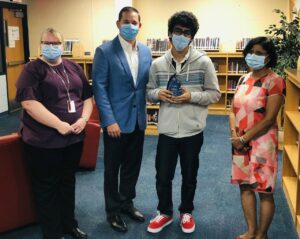Onondaga County Health Commissioner, Dr. Indu Gupta, was notified by the New York State Department of Health Wadsworth Laboratory that a horse in the Town of Lysander has died from West Nile virus (WNV) infection. Dr. Gupta explains that, “West Nile virus is spread by the bite of an infected mosquito; therefore it is extremely important that people use personal protection measures to reduce their risk of being bitten by mosquitoes.”
There have been no virus findings in mosquito surveillance traps in the area where the horse was located, however, due to the death of the horse the Onondaga County Health Department (OCHD) will be intensifying trapping in this area and is planning to conduct truck spraying. The spraying will take place on Monday, September 20 after 7:00 pm, weather permitting. The product used will be Anvil 10+10 ULV and a label can be found at https://www.ongov.net/health/documents/AnvilProductLabel.pdf A written copy of the label can be provided by calling 315.435.1649.
This proactive measure is done in an attempt to interrupt the virus cycle in the mosquito population. If weather or wind conditions are unfavorable, the spraying will be conducted on the next appropriate day. Residents in the spray areas will be also notified by phone through the 911 emergency notification system. A map of the spray area is available at https://www.ongov.net/health/env/documents/SprayMapLysander.pdf.
If you live in the spray area, from 7:00 pm to 10:00 pm on the day of the scheduled spraying, it is recommended that you:
- Stay indoors and keep your windows closed for one hour after the area has been sprayed.
- Keep your pets indoors if possible.
- Set your window air conditioners to circulate indoor air. It is safe to use your central air conditioning.
- Keep outdoor gardens covered and rinse vegetables before eating.
- Be sure children’s toys, outdoor furniture, and clothes on outdoor clotheslines are brought inside. If toys or clothes are left outdoors, wash each thoroughly with soap and water before using and launder clothes before wearing them.
- Close your car windows and car vents if you are driving during the spraying.
This season OCHD reported one finding of WNV, in a mosquito pool from a trap located near the Cicero Swamp on August 25. There have been no findings of Eastern Equine Encephalitis (EEE) virus in Onondaga County this year. As a whole, numbers of mosquitoes in the surveillance traps remain average for the season, however, the recent heavy rains and heat have resulted in the mosquito population being higher than usual for this time of year.
West Nile Virus
Most people who are infected with WNV do not develop symptoms. One in five people with mild cases may develop fever, headache, body aches, joint pains, or rash. People with severe illness usually have a high fever, sudden headache, neck stiffness, altered mental status, inflammation of the brain or membrane of the spinal cord (encephalitis or meningitis). People at greatest risk of developing severe disease are those over 60 years of age and people with certain medical conditions such as cancer, diabetes, hypertension, or who have received organ transplants.
Protect Yourself from Mosquito Bites
This finding of WNV in a horse serves as a reminder for all residents that the virus is present and to be consistent in protecting yourself and your family from mosquito bites no matter where you live.
Personal protection is recommended during outdoor activities by wearing shoes, socks, long pants, and a long-sleeved shirt when outside for a long period of time. Use insect repellents containing DEET, Picaridin, IR3535, oil of lemon eucalyptus, and other products that have been approved by the Environmental Protection Agency (EPA). Follow the manufacturer’s instructions on proper use for safety and effectiveness. Insect repellents should be applied only to intact skin or over clothing. Do NOT apply DEET or Picaridin directly onto children’s skin—apply to your own hands and then put it on the child. Repellent should never be used on babies younger than 2 months old.
Given the significant amount of rainfall in Onondaga County recently, it is extremely important to remove mosquito breeding grounds by eliminating any standing water that may have collected on your property:
- Throw away outdoor containers, ceramic pots or containers that hold water
- Remove all tires from your property
- Drill holes in the bottoms of recycling containers that are kept outdoors
- Clean clogged rain gutters and make sure they continue to work properly
- Turn over wheelbarrows and wading pools when not in use
- Change water in birdbaths at least every four days
- Clear vegetation and debris from the edges of ponds
- Clean chlorinated swimming pools, outdoor saunas, and hot tubs
- Drain water from pool covers
- Use landscaping to eliminate low spots where standing water accumulates
The Onondaga County Health Department remains in close contact with the New York State Departments of Health and Environmental Conservation. For the weekly mosquito pool test results and for more information about personal protection measures against mosquitoes, visit www.ongov.net/health/env/mosquitoes.html or contact the Onondaga County Health Department’s Division of Environmental Health at 315. 435.1649.


